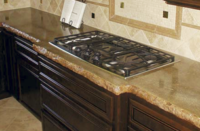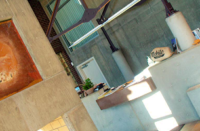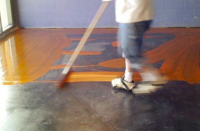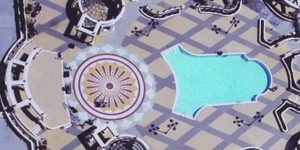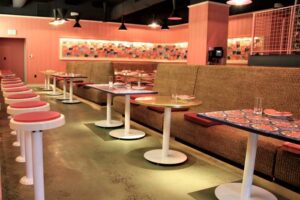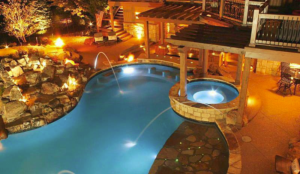
From soft pastels to vibrant purples, Kemiko stains are available in a wide spectrum of color. They’re an excellent choice when trying to obtain colors that acid stain won’t provide.
Barbara Sargent, president of Kemiko Concrete Products in Leonard, Texas, says she first became smitten with Kemiko products when she worked for Lambert Landscape Co., a high-end architectural landscaping firm based in Dallas. “For 21 years, I had the experience of selling Kemiko and incorporating it into gardens,” says Sargent, who now heads up the company that distributes the products nationally. “Anything pertaining to concrete, we ‘Kemikoed.’”
While at Lambert, she explains, she worked hand-in-hand with a dozen architects “who were all crazy about this product.” So she accepted their philosophy and took it home — literally. She used the acid stains all around her house — around the pool deck, in the walkway through her perennial garden, on the patios. “They’re as pretty today as when I first did them, maybe even prettier. The stains are permanent; they’re there to stay.” And the best part, she adds, “The concrete just goes away.”
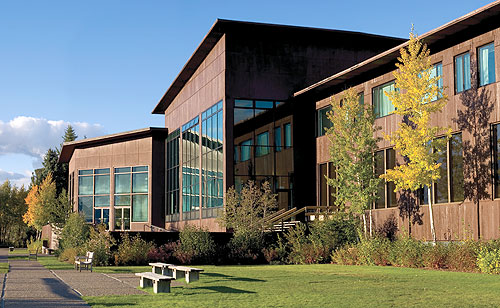
Now you see it, now you don’t
Lambert’s landscape architects detested drab gray concrete because it didn’t go well with their elaborate garden designs. They insisted that a little bit of black Kemiko stain — which consistently produces a mottled tortoise-shell black — went a long way in remedying the problem.
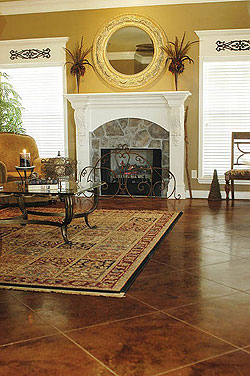 “If you water down our black Kemiko stain and apply it to a garden patio, the concrete will take on a compost hue that resembles the bark of trees,” Sargent explains. “These earth tones produce a softer garden feel that makes the concrete more harmonious with nature.”
“If you water down our black Kemiko stain and apply it to a garden patio, the concrete will take on a compost hue that resembles the bark of trees,” Sargent explains. “These earth tones produce a softer garden feel that makes the concrete more harmonious with nature.”
In addition to black, Kemiko Stone Tone Stains are available in seven other colors from about 100 regional distributors throughout the country. The stains can be used inside or outside. “The most popular is Cola, which resembles old distressed leather,” Sargent says. Next in line is Malay Tan, whose subtle tones are a big hit with interior designers. “It complements any jewel tone,” she says, “and it almost looks like suede.” Nationwide, she adds, she sells a lot of blue and green in desert states, as well as areas along the water.
For a touch of Disney
For those jobs where people want a rainbow of colors, the Kemiko line offers its Rembrandt Polymer Stains. Made with a water-extended acrylic urethane formula, “They’re a complement to our acid stains,” Sargent says. The ultra-low-VOC product is extremely user-friendly and practically void of any odor.
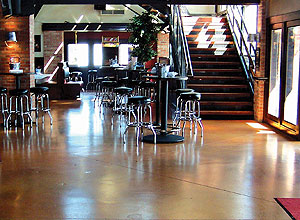
From soft pastels to vibrant purples, they’re available in a wide spectrum of color. “They’re an excellent choice when trying to obtain colors that acid stain won’t provide,” Sargent says. “They’re what we call our ‘Disney World’ colors, as they produce true reds, true yellows. They’re very appealing for such facilities as day spas, children’s care centers and retail outlets.”
In addition to Kemiko’s product lines of acid and polymer stains, the company offers sealants and waxes to help protect decorative concrete surfaces. “Our sales nationwide [of protective products] consist of 90 percent concrete wax and 10 percent sealer,” Sargent says, adding she recommends wax for the ultimate finishing touch.
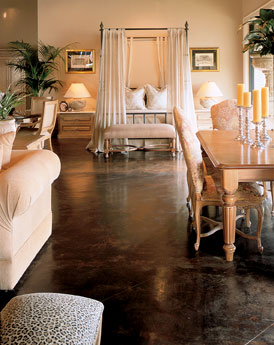 “The wax, which is easy to apply and easy to maintain, is driven down into the concrete,” she explains. “It’s formulated to produce a low-satin sheen, and if it’s applied properly, the surface only needs to be waxed every couple of years and damp-mopped as needed. Once you try it, you’ll love it.”
“The wax, which is easy to apply and easy to maintain, is driven down into the concrete,” she explains. “It’s formulated to produce a low-satin sheen, and if it’s applied properly, the surface only needs to be waxed every couple of years and damp-mopped as needed. Once you try it, you’ll love it.”
Excellent training tops the list
For training, Sargent has hooked up with Bob Harris, president of the Decorative Concrete Institute. She says she met him at a recent World of Concrete and the two just clicked. “We share the same business philosophy in that we both very strongly feel that a contractor’s success in the decorative concrete industry depends on training. Not just good training, but excellent training, by an instructor with real-world experience who understands concrete and what can be accomplished with it.”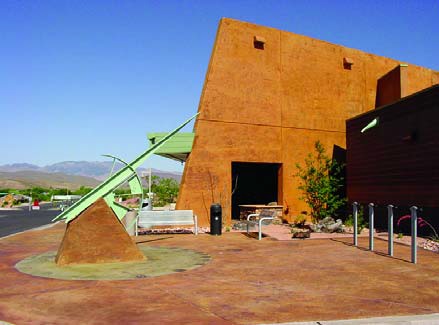
Harris, who not only founded DCI but is also the author of two best-selling books, easily fits that bill. “Bob, having personally placed or supervised more than 3 million square feet of decorative concrete, is in an elite league that sets his training workshops apart from so many others out there,” Sargent says. “Knowing your trade is one thing, but you’ve also got to be committed to improving your skills and knowledge for the betterment of the industry as a whole.”
Couple this ongoing training with a good product, she says, and you come up with a winning combination.
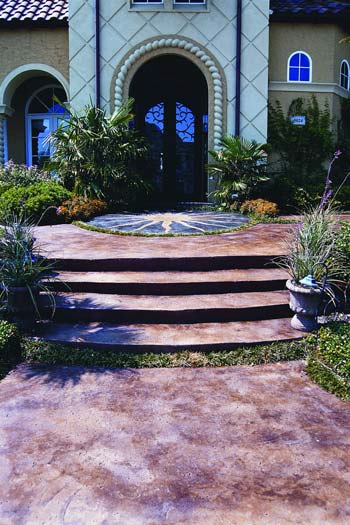 Decorative concrete: It’s here to stay
Decorative concrete: It’s here to stay
“I’m frequently asked if the decorative concrete stain trend might be a fad or a temporary explosion,” Sargent says. “And I’ve put a lot of thought into my answer.”
For starters, such architectural greats as Frank Lloyd Wright believed in decorative concrete. “He used Kemiko concrete stain throughout his career,” she says with obvious pride. And back in 1955, the Jackson Lake Lodge in Moran, Wyo., was coated with black and brown Kemiko stains to help the structure blend with the Teton Range. The structure is not only still intact, but “the concept is growing stronger each day,” she maintains.
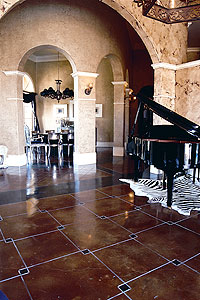 Sargent says when she first began marketing Kemiko products nearly 10 years ago, she thought concrete staining was, for the most part, applicable for industrial and commercial settings. Still, she thought there was a place for it in the residential market. “I thought concrete was a low-point price product that might fill a niche for low- to moderate-income levels,” Sargent says, “but I was wrong. Once I started marketing it to homeowners, I realized it was consistently being used in higher-end projects.”
Sargent says when she first began marketing Kemiko products nearly 10 years ago, she thought concrete staining was, for the most part, applicable for industrial and commercial settings. Still, she thought there was a place for it in the residential market. “I thought concrete was a low-point price product that might fill a niche for low- to moderate-income levels,” Sargent says, “but I was wrong. Once I started marketing it to homeowners, I realized it was consistently being used in higher-end projects.”
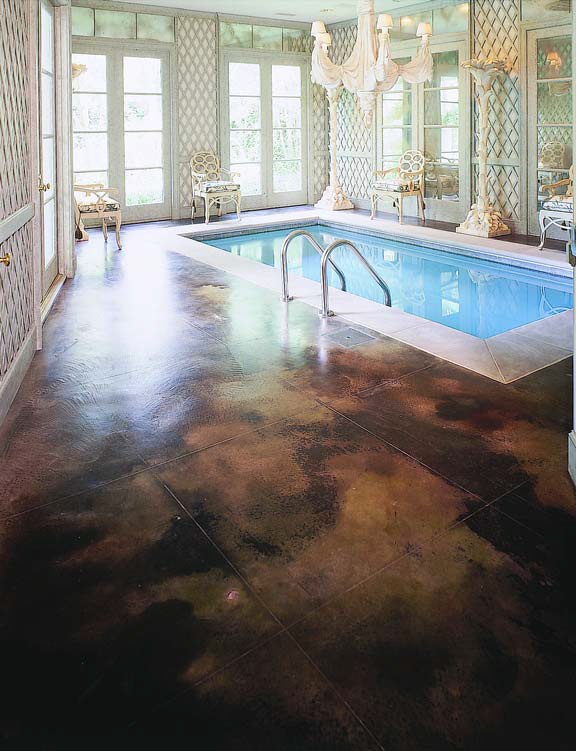 The reasons are many. Concrete costs less than the materials it mimics, such as slate and marble. It’s easy to maintain and there are no down-the-road replacement costs like the ones homeowners experience with carpet and vinyl. It’s a great flooring product for those with allergies and pets.
The reasons are many. Concrete costs less than the materials it mimics, such as slate and marble. It’s easy to maintain and there are no down-the-road replacement costs like the ones homeowners experience with carpet and vinyl. It’s a great flooring product for those with allergies and pets.
“And people appreciate it for its sheer natural beauty,” Sargent sums up. “None of these reasons conjure up a fad. I think concrete flooring is here to stay. The customers like the look and feel of the product, and their checkbooks like the savings.”
For more information visit the Kemiko Web site.
